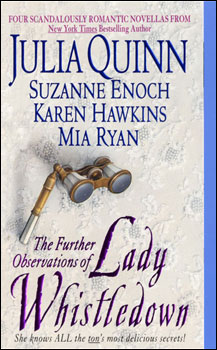 If you’re a fan of Julia Quinn’s Bridgerton series, then you’re well-acquainted with Lady Whistledown, the anonymous society lady who writes the wildly popular gossip sheet about London’s ton.
If you’re a fan of Julia Quinn’s Bridgerton series, then you’re well-acquainted with Lady Whistledown, the anonymous society lady who writes the wildly popular gossip sheet about London’s ton.The fun part about this anthology, unlike many others, is the fact that the four stories bump into each other around the edges, much like you might expect four actual affairs going on within, loosely, the same large social set. They don’t have too much impact on each other, but there are a couple of events that we get to see from several different vantage points, which I think is always fun. And then there’s the narration of Lady Whistledown. Her gently snarky commentary is funny, never truly kicks anyone who’s down, and serves as a wry window into the foibles of the nobility from someone who lives in the midst of it.
Briefly then –
*Suzanne Enoch leads us off with a nineteen-year-old virgin theme. Not my fave, but probably the most historically accurate for a Regency, so, you know, I’m used to it and I deal. It has a classic arranged-marriage conflict – not much in the way of word-count is needed to get us up to speed on that. We do get to see these characters come around from playing the role that’s expected of them, to really seeing each other as individuals and figuring out how to compromise. Nicely done if not especially memorable.
*Mia Ryan’s Lord Darington, has to be the most… endearing hero I’ve some across in a long time. I can’t find the right word. “Endearing” makes him sound like a puppy or a child, and that’s not what I mean. He has a serious vulnerability, and when he exposes it to the heroine, it’s really a wonderful scene, especially for a short. “A Dozen Kisses” is a nicely wrapped testament to the adage that Appearances can be Deceptive. It wins my vote for “Best Love Letter Ever,” too.
*I loved Karen Hawkins heroine, loud wardrobe and all (I did sort of wonder a bit if the character was color-blind, but that didn’t go anywhere). This is a Best Friend theme that hits all the right notes; it’s not a sudden transformation of a friendship—the whole story is really a progression where the characters realize that their friendship has been masking deeper feelings all along. My only complaint is that the hero seemed genuinely puzzled as to why the heroine would want to get married—hello, duh, sex? Anyway.
*Quinn’s “Thirty Six Valentines” is a sweet-cotton-candy melt-in-your-mouth fluff of a story. It’s almost more of a character sketch than a story, but I’m OK with that because the characters are eminently loveable, their vulnerabilities human and universal, and the sketches rendered flawlessly.
In direct contrast to Betsy’s complaint about the Foster and Phillips stories, these four all show us couples falling in love. As Betsy so eloquently put it, the relationship is the action. Plot and conflict are scaled down to novella-length, but I really felt like the characters and the chemistry still got the full, royal treatment in all four stories.
____________
p.s.: Visit Devon's blog for her latest anthology review.

No comments:
Post a Comment